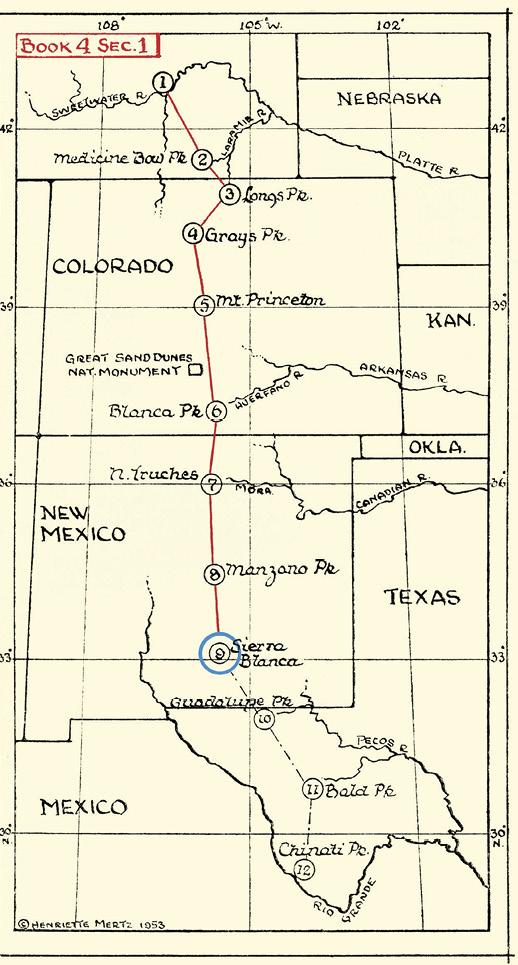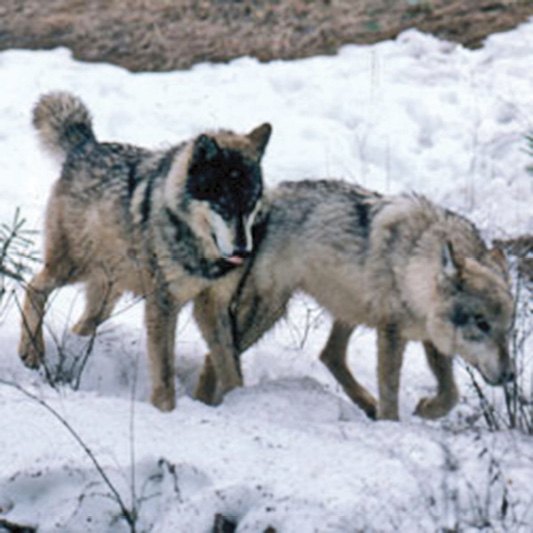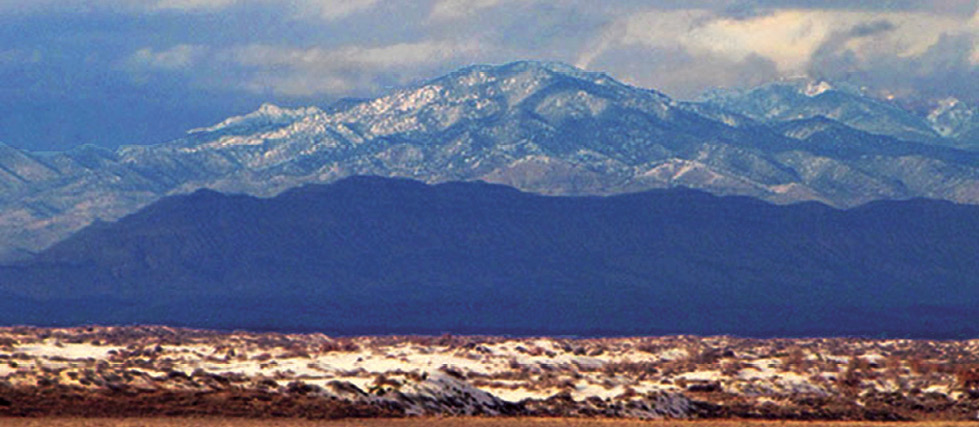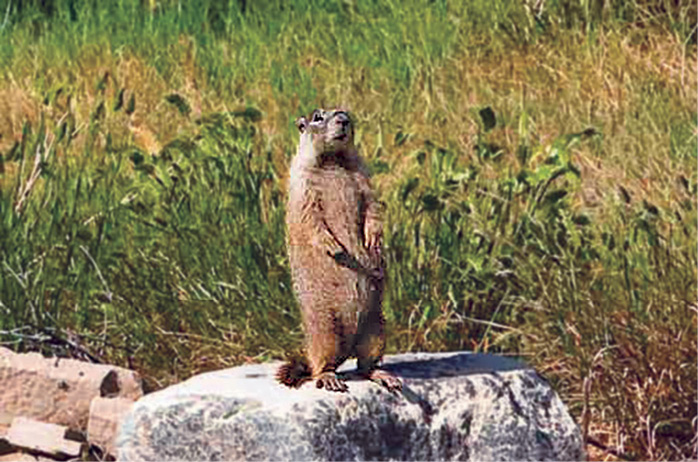10 – Sierra Blanca, New Mexico
And it says that, three hundred li to the south, Wolf Mountain is to be found. Upon this there is no grass and there are no trees, and below it there is much water (or there are many streams), in which there are many KAN-TSZ fish. [These are not fully described.] They have wild animals, which look like the (quadrumana, called) KW’A-FU, but they have hair like that of swine and their voice is like an expiration of the breath. When these are seen, then heaven sends down great rains. (Vining translation of Shan Hai Jing)

Mertz note:
95 miles south of Manzano is Sierra Blanca, with many noisy streams chasing down its slopes – two main tributaries flow into the Rio Hondo. The wild animals that look like swine and are the size of monkey, I am not able to identify – they may be small peccary.
Author’s Comments:
As previously stated, “Blanca” means “white” in Spanish. Sierra Blanca is also known as White Mountain. According to the Mescalero Apache web site:
The range is about 40 miles from north to south and 20 miles wide, and is dominated by Sierra Blanca Peak….much of the southern half of the range, including the summit of Sierra Blanca Peak, is part of the Mescalero Apache Indian Reservation, and requires a permit for access.133
“Sierra Blanca is a significant sacred site in Mescalero Apache culture.”134 Although the Mescalero Apache web site says that access is only by permit, since 1963 that tribe has operated a resort now called Ski Apache on Sierra Blanca. The tram ride up is said to be spectacular. From the resort are several miles of hiking trails.135
The Chinese named this “Wolf Mountain.” That would seem to imply that they saw wolves there.

Wolves - courtesy of NPS
Gray wolves (canis lupus) in North America originally had a range from the arctic down to Mexico,136 but today are usually found only in far northern areas.
An analysis of the petroglyphs of the Sierra Blanca region by Dr. Robert H. Weber of the New Mexico Bureau of Mines and Mineral Resources mentions that among the petroglyphs: “Tracks of bear and wolf are… clearly delineated.”137 To correctly draw wolf tracks, the artist had to have seen real wolf tracks, and probably even wolves. The oldest petroglyphs of that area are thought to date back to around AD 900.

Wolf tracks - courtesy of NPS
Zooarchaeology of Six Prehistoric Sites in the Sierra Blanca Region, New Mexico studied areas thought to be from AD 1100 – 1450. They found coyote and dog bones, but specifically stated that they found nothing large enough to classify as wolf. Perhaps the wolves had died out by then. If so, one might conclude that whoever made the wolf tracks on the petroglyphs did so before AD 1100 and that if the Chinese really did make this Shan Hai Jing journey they were there before the wolves died out, also.
Microbiologist Dr. Simon Southerton stated in Losing a Lost Tribe:
Mitochondrial studies suggest the New World dogs were faithful companions during the early settlement of the Americas. DNA sequences obtained from pre-Columbian dog remains in Latin America and Alaska have been compared to the DNA of dogs and wolves from around the world…and it is now clear that New World dogs occupy the same branch of the canine family trees as modern Eurasian dogs. The American gray wolf is a distant cousin. It would appear that when humans crossed…into the Americas, they were accompanied by their canine companions.138
Sierra Blanca Peak sits at 11,973 feet and is also part of the Sangre de Cristo range of the Rocky Mountains. As the Shan Hai Jing described, the top of Sierra Blanca Peak has no grass and no trees. Today locals call it “Old Baldy.” However, there are several different life zones found on the mountain. Various plants and trees can be found growing up to certain elevations.139 As with other mountains on this range, the western slope is much more barren than the eastern.

Photo courtesy of NPS
When driving there from Los Lunas where we were staying, this location seemed very remote. On one side of the highway for many miles as we drove east then south was a huge missile range. It is considerable distance between houses. After all, who would choose to live next to a missile range?
It had rained two days earlier. Many flowers of various colors including red, orange, white, and yellow bloomed next to the highway in this otherwise desolate region. We drove through an area where the rocks were all black. Later we learned that this was called “Valley of the Fires.” Reportedly it was caused by a volcanic eruption only a thousand years ago.140
After almost three hours of driving, we finally arrived at the small town of Carrizo where we stopped at a convenience store. The school mascot there is a grizzly bear. Someone had painted its depiction on the wall of the store. I asked if there are still grizzlies there. The store clerk replied that because of the drought, bears from the mountains had been showing up in town lately in the middle of the day. Those bears making appearances in Carrizo may be distant relatives of the famous Smokey the Bear, a cub saved from a forest fire in nearby Capitan Gap in 1950.141
There are bears there, but according to a park ranger, no more grizzlies. Other large animals in that part of New Mexico include mountain lions weighing up to 190 pounds. The internet displayed the photo of a large one in this area recently shot by hunters. Even up in the Sandia Mountains, which are much closer to heavily populated areas, in 2008 a young child was picked up by a mountain lion, but was released relatively unharmed.

Mountain Lion - courtesy of NPS
The KAN TSZ’ named here appears to be the same fish (trout) mentioned at Mt. Princeton and Blanca Peak.
Fly Fishing in Southern New Mexico states:
Rio Ruidoso is a small freestone river originating on the southern slope of 12,000 foot Sierra Blanca, 10 miles west of Ruidoso, New Mexico. It starts as three forks joining together on the Mescalero Apache Indian Reservation then flows through the city of Ruidoso east to its confluence to the Rio Bonito where the Rio Hondo is formed.142
That text indicates that brown trout are found there in a 35 mile long section of Carrizo Creek and Rio Ruidoso.
We previously mentioned that the US Geological Survey (USGS), a scientific agency of the US government, indicates that brown trout are not native to the Americas and that they sometimes replace the native fish. That study also stated that natural reproduction of brown trout is low or nonexistent in most states.143
However, the local web site for the City of Ruidoso indicates that while other trout are restocked in the local streams, brown trout there are not restocked because Carrizo Creek is Ruidoso’s natural hatchery and nursery for them.
They have become so acclimated there that this web site referred to brown trout as “native.”144 Even if the brown trout there now have replaced the native fish, this seems an ideal spot for that species.
The Shan Hai Jing describes many streams at Sierra Blanca. As stated above, Rio Ruidoso has three main forks flowing east from Sierra Blanca. Rio Ruidoso translates from Spanish as “noisy river,” presumably the noise was from water rushing down the slopes. If one views Sierra Blanca Peak, New Mexico on Google Maps, he will see several more streams and rivers that flow down the west side of that mountain. Three Rivers Petroglyph Site is near where three westward flowing rivers from that mountain range converge.

Three Rivers Petroglyphs in foreground & Sierra Blanca in background
Dave and I walked through the delightful petroglyphs of the Three Rivers Petroglyph Site and photographed Sierra Blanca from there. This petroglyph site is under the protection of the Bureau of Land Management. It boasts more than 21,000 glyphs scattered over 50 acres of desert. They are thought to date back to AD 900-1400 and are attributed to Jornada Mogollon. However, not far away are two different archaic sites, Alamagordo and Parabolic Dune Hearth Mounds which have each been dated to 2000 BC. Alamagordo had a large amount of perishable material that was tested.145
Weber wrote concerning the Three Rivers Petroglyphs:
The figures are highly varied and may be of more than one age. Among the forms noted are realistic, stylized human figures, heads, handprints, footprints, and possible mythical beings, corn plants…geometric patterns….Among the animal figures are birds in flight and at rest (a highly realistic quail, roadrunners, turkeys, possible macaws, and others). Lizards, frogs, turtles, snakes, beetles, butterflies, worms, fish, deer (a spotted fawn is especially noteworthy), rabbits, chipmunk, skunk, mountain lions, and mountain sheep. Tracks of birds are common: some are aligned in trails that trip lightly across the tops of boulders.…Human figures are largely stylized stick and solid forms of considerable variety. Goggle-eyed faces are repeated at several places….Masks and headdresses are indicated on several figures ….Cultural affiliations of the Three Rivers petroglyphs have not been established.146

Caucasians visualize a man in the moon. Asians and Native Americans see a rabbit. Some believe this Three Rivers, N.M., petroglyph depicts the ancient Chinese tale of how the rabbit reached the moon.
Among the petroglyphs at Three Rivers is a very Asian looking face. At this site we saw more petroglyphs with less walking than at Boca Negra Canyon.
I disagree with Mertz in her conjecture of what KW’A-FU was. The Shan Hai Jing described it as an animal that looked like a quadrumana (a primate, a monkey). Mertz guessed that the animal described by the Chinese was a peccary – an animal in the pig family.
Further south on this same Shan Hai Jing journey, at Baldy Peak, Texas the Chinese mention another animal which Mertz also thought was peccary. I believe Mertz had the correct interpretation for that animal in Texas. However, the Chinese name in the Shan Hai Jing for the animal at Sierra Blanca and the one at Baldy Peak are different. Surely if the Chinese saw another similar animal on that single trip they would have named it identically as they did with the KAN-TSZ fish.
As Mertz knew, peccary are occasionally found in the vicinity of Sierra Blanca. Just a few days after Dave and I were in that area, the news reported that a wild peccary with razor sharp tusks, which could have destroyed a pet dog in seconds, was discovered walking down the street in Ruidoso and was shot by a police officer.
I could not find evidence of peccary there in the distant past. However, my main argument against peccary is that they look nothing like monkeys. Note that the Shan Hai Jing says that the animals looked like monkeys but had hair like swine.
As a child in Taiwan I played with my family’s pet monkey and dressed it up in doll clothes. One of the peculiarities of monkeys is that their feet are similar to hands. My pet liked to suck his thumb or his big toe. Monkeys have a distinct way of walking that is similar to a bear or a human in that their entire foot touches the ground. This foot posture, called plantigrade, is not real common in animals.

Yellow Bellied Marmot - courtesy of NPS
There is an animal living in the area of Sierra Blanca and native to America which does have plantigrade foot posture.147 It stands almost the same way that monkeys do. Yellow bellied marmot (marmota flaviventris), which is in the rodent or squirrel family, could be compared to a fat monkey. This animal is native to the Americas. It whistles or chirps or makes a chucking sound when startled. It has lots of hair like a monkey, but the hair is coarse – like that of a pig, as the Shan Hai Jing contended.
Marmots are found in the Sangre de Cristo Mountains in New Mexico. Palaeoecological results from that area confirm the presence of marmots there at very early dates.148